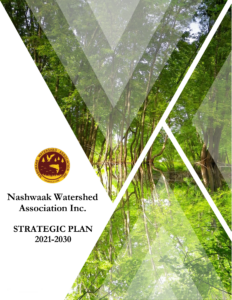Strategic Plan
Strategic Plan 2021-2030
In 2020, the Nashwaak Watershed Association undertook a strategic planning process following the Conservation Standards methodology to systematically plan conservation initiatives for the coming decade. The strategic plan considers biodiversity targets like floodplain forests and riparian zones, examines pressures like agriculture, forest harvesting, and urbanization, and proposes goals, strategies and interventions to protect and improve the health of the biodiversity targets. It also outlines monitoring initiatives to track, adapt and improve conservation over time.
target
one
Floodplain Forest
Goal
By 2030, the extent of floodplain forest in the Nashwaak Watershed will increase from 21% to 25% (i.e. from 368ha to 439ha)
target
two
Riparian Zone
goal
By 2030, the percent of natural cover within a 30m buffer of streams and rivers will meet or exceed 93%.
Target
three
Wetlands
goal
By 2030, the total area of wetlands will meet or exceed 89% of the historic wetland extent in the Nashwaak Watershed.
target
four
Wabanaki Forest
goal
By 2030, the total area of mature Wabanaki forest will meet or exceed 22% of forest in the Nashwaak Watershed.
target
five
Aquatic Habitat
goal
By 2030, the total length of streams and rivers in the Nashwaak Watershed that are unobstructed by barriers will increase by 110 km.
The strategies in the plan to achieve these goals are to:
one
Restore priority ecosystems
two
Increase protected and conserved lands
three
Remove barriers to fish passage
four
Carry out community education and outreach toward achieving a healthier watershed, and
five
Advocate for a healthier watershed

Strategic Plan 2021-2030
Download the Strategic Plan to find out about the situation analyses for each pressure, the theories of change for each strategy, and the specific interventions to be undertaken under each strategy area.
Get the latest news right to your inbox!
Subscribe to our monthly e-blast email newsletter to stay up to date on news, projects, events and more!
